
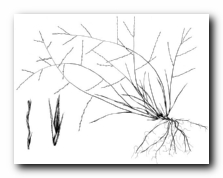
-DSCN4382Original.jpg)
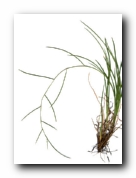
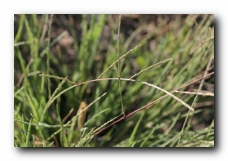
-Dscn4385.jpg)
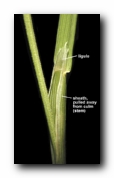
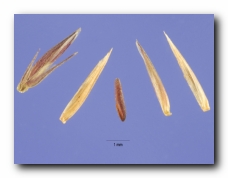
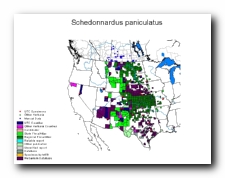
40" Rows:
Broadcast:
Sandy:
Loam:
Clay:
Habit: Annual, branched at the base.
Culms: 20-40 cm. tall, scabrous, erect or decumbent at base, leaves crowded
at the base, at maturity the axis of the plants elongates to over
half the length of the plant and the scythe-shaped culm turns downward
with the tips of the panicle touching the ground. Finally the panicle
breaks away as a tumbleweed.
Blades: 2-5 cm. long, 1-2.5 mm. wide, flat, stiff, wavy, smooth, except
minutely scabrous on the white margins, spirally twisted when old.
Sheaths: Loose, flattened, crowded at the base.
Ligule: Membranous, 3 mm. long, decurrent down the margins of the sheath.
Inflorescence: Panicle half or more than half the entire height of the plant,
its axis usually falcate, rachis hispid, the 3-13 slender spikes
solitary and separated 1-5 cm. remote, mostly along the convex
side, rigid, and widely spreading, becoming curved in a loose
spiral, breaking away at maturity as a tumbleweed.
Spikelets: Narrow, acuminate, 3-6 mm. long, sessile and appressed,
1-flowered, alternate on opposite sides of the long, slender,
3-angled rachis, forming several long, slender spikes, rachilla
disarticulating above the glumes, not prolonged.
Glumes: Narrow, stiff, acuminate, somewhat unequal, hispid on the one
nerve, margins scarious, first including the awn 2-4 mm. long
(the awn about one fourth of the length), the second 2.56 mm.
long (the awn one third its length).
Lemmas: Narrow, rigid, acuminate, 3-5 mm. long, longer than the body of
the second glume, with 3 green nerves, rounded on the back,
minutely hispid on the upper part, slightly pubescent.
Palea: Narrow, nearly as long as and enclosed by the lemma.
Fruit: Grain free within the subrigid lemma and palea.
Habitat: Prairies and plains. July-September.
Remarks: The spikelets quite variable.
Special Notes: